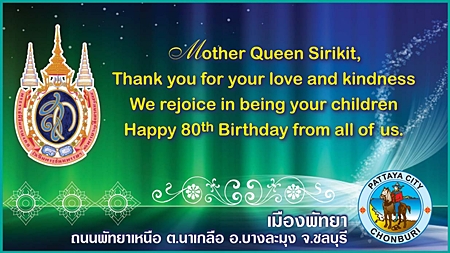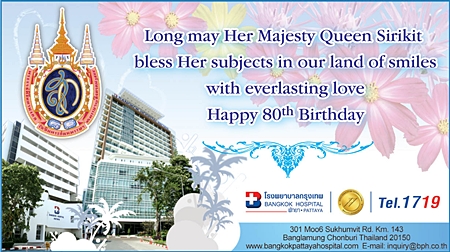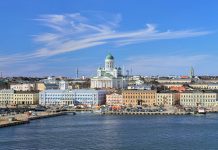Power of Love
The Committee for Documentary Compilation and Archives
Photographic Credit: The Royal Private Department of Photography, Office of the Royal Household; Royal Private Film Her Majesty the Queen’s Personnel Affairs Division
The Pattaya Mail Media Group joins the entire Kingdom in humbly extending our best wishes of loyalty and devotion to Her Majesty Queen Sirikit on the auspicious occasion of Her 80th Birthday, August 12, 2012.
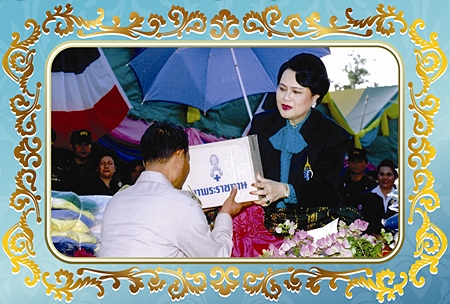
Introduction
For over 60 years of His Majesty the King’s reign over the Kingdom of Thailand, Her Majesty Queen Sirikit has resolutely followed his guiding principle and course of action with regard to the numerous activities pertaining to the welfare of their subjects. With a strong determination to alleviate the hardship and suffering of the rural people, the royal couple has devoted time and energy to find effective solutions for a better living, with sufficient income, in order for them to enjoy a peaceful and happy existence.
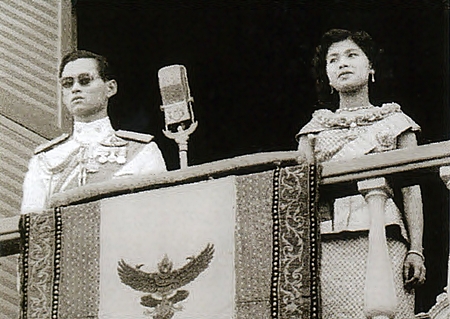
It is with this special royal Power of Love that has enabled them to carry out their responsibilities with unwavering dedication and caring concern, without exception or discrimination, for all their subjects. The Royal Secretariat to Her Majesty the Queen and the SUPPORT Foundation continue to actively carry out the royal guidelines and procedures to extend assistance and support to the people.
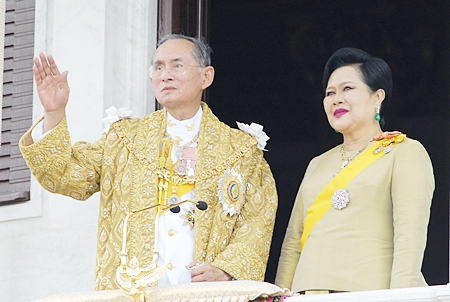
Through this supplement, The Royal Secretariat to Her Majesty the Queen and the SUPPORT Foundation, along with the Pattaya Mail Media Group, hope that readers will now understand and appreciate the hard work and unceasing activities, which have been initiated and continue to be meticulously carried out until the present, are all due to the immense Power of Love and infinite sympathetic support that Her Majesty has for all her people.
Patients under Royal Care
“I firmly believe that healthcare is a very important issue because it is the essential foundation of life, according to the age-old saying that ‘an active mind requires a healthy body.’ If our people enjoy good health and are not suffering from any chronic illnesses, they will have the ability to study and enjoy higher education. Later, they can hold an occupation or a profession which will assist in developing and promoting the advancement of the nation.” – Her Majesty the Queen’s Speech to the Thai people, on the occasion of her Birthday Anniversary August 11, 1988 at Dusidalai Hall, Dusit Palace, Bangkok
For over 40 years, it is the annual practice of Their Majesties to spend a certain period of time at each of their regional palaces. They make daily visits to surrounding villages and travel to remote areas to promote the welfare of their subjects, who are filled with deep gratitude for their caring concern and continuous support.
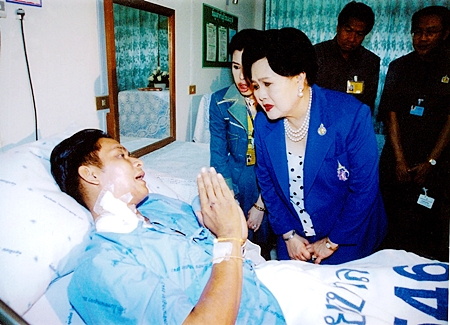
During those early visits, it has come to their attention that their people are suffering from various ailments without proper care, due to lack of doctors and nursing facilities. It is most unfortunate that this very important aspect in the development process of the country has been overlooked. Human resources are essential for the advancement of a nation, which cannot progress effectively if its people are weak and unhealthy. Therefore, at each location, doctors who always accompany the royal entourage will extend immediate medical assistance to the villagers. The seriously ill are sent to the nearest hospital or onto Bangkok according to the severity of the illness. These people are known as Patients Under Royal Care.
Later on, Her Majesty the Queen took over the duties with regard to social welfare and medical support in order to reduce some of the numerous responsibilities of H.M. the King. On each visit to underprivileged villages and remote areas, they observe that a huge number of people are obviously very ill. But for some, the symptoms have not yet shown up and these are sometimes overlooked for medical assistance.
However, Her Majesty has a talent for being able to pick out sick people in a crowd by just looking into their eyes. She stops to chat and puts them at ease by casually inquiring about their family and general well being. Then she will instruct a doctor to give basic medication or whatever else that is needed to take care of these people.
In the meantime, H.M. the King is occupied with inspection trips to search for suitable water sources and establishment of appropriate irrigation systems for agricultural projects.
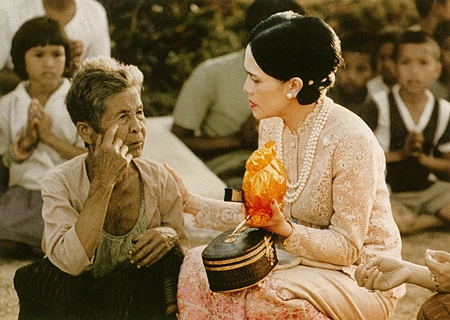
For her long sessions with villagers, H.M. the Queen will settle herself at a designated area such as in the temple grounds, a space in front of a house or even a shady patch in a rubber plantation. The natural elements of heat, high humidity or drizzling rain do not deter her from her earnest wish to give assistance to her subjects. She sits on the ground, informally chatting with the gathered villagers. Sometimes, she will even spread out a piece of plastic cloth near her for them to sit on.
Meantime, doctors start basic examinations, with medicines prepared and distributed accordingly. Members of the royal entourage help to record information on each patient and jot down comments for further medical care.
Her Majesty is most concerned with the health of children, especially when it was discovered that they had never received the necessary vaccinations to prevent tuberculosis, whooping cough, tetanus, diphtheria or polio, as it was not yet possible for the local public health services to reach these remote villages. Therefore, her doctors always travel equipped with these required vaccinations.
Members of the royal entourage distribute milk, prepared in baby bottles, to under-nourished infants. Iodized salt are also distributed, especially to the people in the north and northeast (Issan), where goiter is widespread due to lack of iodine.
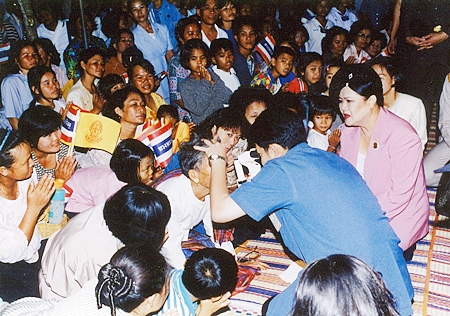
Although seriously ill, some people are frightened of modern medication and filled with fear at the thought of surgery. Her Majesty always takes time to explain patiently the necessity of such a medical procedure, which will finally persuade them to take the appropriate treatment. Then it is the turn of the ladies-in-waiting to make regular hospital visits and report back to her on the progress of each case.
Patients are given baskets of nutritious drinks and some personal items to make a hospital stay more comfortable. For the accompanying relatives, travel and pocket money are arranged for them accordingly.
Her Majesty’s deep concern and sympathy for the plight of her people is endless. To effectively extend medical assistance, she has established the Patients Under Royal Care Division as part of the Royal Secretariat to H.M. the Queen, with appropriate procedures in the treatment of patients. Her accomplishment is in line with the direction set by H.M. the King in providing close supervision and the most efficient medical care.
Later on, more and more sick villagers would travel from long distances to gather in front of the royal provincial residence, eagerly awaiting the scheduled arrival of Their Majesties. Therefore, it became the practice of the Royal Mobile Medical Unit to travel in advance in order to extend prior treatment.
The Royal Mobile Medical Unit originated in Chiang Mai at Ban Mae Tho, Tambol Bo Salee, Amphoe Hod in 1970 with Professor Dr. Danai Snidvongs na Ayudhaya as chief of the unit, assisted by a group of ladies-in-waiting. The royal doctor, Dr. Pramote Sophark is also another unit chief, but travels separately to carry out duties in different areas. Later on, a team of specialists from several hospitals, together with a group of rotating volunteers, always accompany the unit on each visit.
On a daily basis, a huge crowd of sick villagers gather in front of the provincial royal residence, anxiously awaiting some medical assistance. Therefore, Her Majesty instructs the Royal Mobile Medical Unit to set up a medical center right there, which is simply known as the “Palace Front Medical Unit” such as at Phuphan Rajanives in Sakon Nakhon and at Taksin Rajanives in Narathivas.
The unit starts treatment in the early morning at the palace, and later in the afternoon accompanies Her Majesty on her daily provincial visits. A group of ladies-in-waiting help in dispensing medicines (later they are assisted by palace officials to prepare the medicines). After examination by a doctor, if necessary, the patient is then sent to a nearby hospital. The royal secretariat officials prepare the necessary letter of admittance for hospitalization, confirming that this particular patient is under royal care. However, if the hospital is far away, then travel money is provided, and the patient is escorted by a village official or border patrol police, and later accompanied home.
Some patients undergo surgery by “Volunteer Doctors” who are stationed at nearby local hospitals during the royal visit. The volunteer doctors program was initiated when Their Majesties were on a visit, in 1973, to the Southern Settlement Development Project at Amphoe Waeng in Narathivas Province. At that time, there were no doctors or nursing facilities, and a trip to the hospital required travel through remote and dangerous areas.
After consultation with the public health minister, Professor Dr. Udom Posakrisana, he immediately organized a rotating group of doctors to make regular inspection trips to the public health center at King Amphoe Sukhirin, Narathivas. Later, the project expanded to include a group of rotating volunteer specialist surgeons from several hospitals, who contributed their expertise in extending the much needed medical treatment at the Narathivas Hospital during the royal visit. Thus, began the “Volunteer Doctors” project headed by Siriraj Hospital doctors and nurses, followed by the University of Surgeons, who took on the additional responsibility of recruiting specialists from various medical fields to carry on this valuable contribution, which continues until present, during the royal provincial visits.
In the case of patients suffering from an illness that cannot be treated locally due to lack of equipment or a specialist such as patients with heart problems, brain damage or needing constant close care, they will become the responsibility of the relevant division at the royal secretariat to H.M. the Queen, which will make arrangements to bring these patients to Bangkok to receive appropriate treatment. Travel money is provided together with food or train tickets. If they cannot travel alone, relatives can accompany with help from the border patrol police or a village official, who will deliver them to the royal secretariat at Chitralada Palace, Bangkok.
For over 40 years, the State Railway has contributed towards this royal charitable assistance by organizing complimentary train vouchers for these patients. On arrival in Bangkok, the official concerned will open a file for personal data and detailed information on the illness in order to make appropriate arrangements.
While awaiting treatment by a specialist or during convalescence after surgery, these patients are accommodated at a rest house at Sukantharam Road in the Dusit district in Bangkok area. The house is divided into male and female sections and is monitored on a 24-hour basis. Food, of three meals daily, is provided from the royal kitchens at Chitralada Palace, with choices of halal Muslim food, supplementary food, nutritious drinks for the elderly, special diet and milk for infants. Personal items such as soap, toothbrush, towel and talcum powder are also provided.
There is a van for hospital visits escorted by officials, who will also accompany the patient during a doctor’s examination and wait for the results.
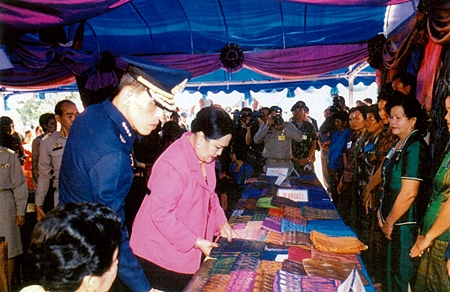
At present, there are 200-300 patients each month receiving care or being hospitalized in Bangkok. For patients who are hospitalized far away from home, ladies-in-waiting and volunteers make rotation visits to give them warmth and comforting support. A report is kept on the progress of each patient, which is most helpful to the medical division of the royal secretariat. When a patient is fully recovered, arrangements are made for the return trip home, together with periodic hospital visits, as necessary. If a patient dies, then a proper funeral is arranged according to the particular religious rites.
Her Majesty’s medical assistance is not limited only to those who are in attendance during her provincial visits. Assistance is also extended to those people reported by the media, such as newspapers or television, who are suffering from a serious illness, a rare disease or accidentally hurt while doing a good deed as a helpful citizen. Medical assistance is extended until recovery, no matter how high the expenses. Assistance is also given to numerous impoverished villagers who have written to request for help.
Patients under royal care are assured that they will receive the best medical assistance, not only for them but it is also extended to their needy families. Arrangements are made with village officials and members of the local Red Cross to take care of parents or infants. Cash contributions are also given to families until the patient is recovered. In the case of a patient who cannot reach full recovery or has become handicapped with lost limbs and cannot earn a living, Her Majesty will take these under royal patronage or bring other family members to be trained in handicrafts so they can have a profession and will be able to help their family.
Her Majesty’s project of Patients Under Royal Care is effective with the most satisfactory results. Impoverished and sick people, without hope, are given a new lease on life and are able to enjoy a normal family environment again. For those who are not entirely cured, they can still lead a contented existence for many more years. Handicapped people are encouraged and given a chance to create their own profession. Some who think they are terminally ill have miraculously recovered, or those who are ignorant and have such a great fear of any medical care have been persuaded to undergo successful treatments. Her Majesty’s unceasing compassionate concern and sympathetic understanding have brought peace and hope to the people, without discrimination toward any to either class, race or religion.
Students Under Royal Patronage
“Our present day youth is our country’s future. They will be instrumental in the effective development and successful growth of the nation. As a mother, I wish to see all children enjoying a happy childhood, and lovingly cared for from a young age. When they grow up, they will be an asset to the community. They will be ready to assist in developing and promoting the progress of the country and also of the world as a whole.” – Her Majesty the Queen’s Speech, on the occasion of the opening ceremony of a UNICEF event January 13, 1964 at Sala Santitham, Bangkok
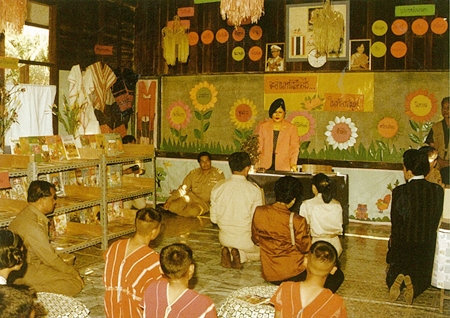
Education is a significant basic foundation and a most important factor for a successful life. It will promote progress and bring security for the future, together with developing a person to be informative and cautious in bringing knowledge and experience to create a profession suitable for himself or herself and generate a happy environment for family and fellow citizens.
An educated person is similar to an individual who is equipped with a personal shield safeguard against being taken advantage of, as well as being easily mistaken or misguided. If a nation is composed of well educated citizens, then it is certain that they will be instrumental in bringing prosperity and stability to the land.
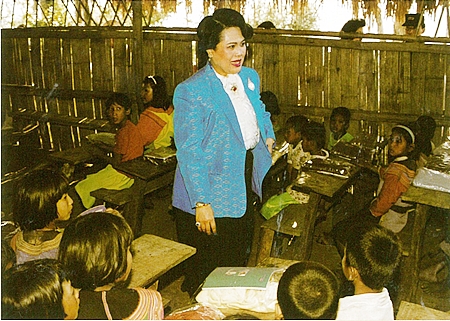
Her Majesty the Queen is fully aware of this from accompanying H.M. the King on their visits to all corners of Thailand. Besides finding people suffering from various ailments, she discovers that the people in underprivileged and remote areas are destitute and existing in a hand to mouth manner. On top of that, they are totally illiterate, without the benefit of any form of education.
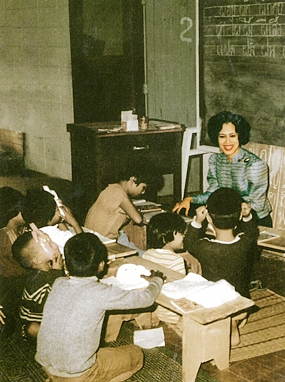
Due to their bleak and impoverished circumstances, children do not have the chance of an education, and even a few fortunate ones who attended school have to leave early to find jobs and help support their family. By the time they grow up, they have already lost the chance for education and are unable to make any effective progress for themselves.
With her far sighted vision and grave concern for this situation, Her Majesty searched for ways and means which will alleviate these problems and make all-round improvements.
If a family is so poor and has no land to make a living or is burdened with family responsibilities of too many children, Her Majesty will recommend a suitable occupation which will enable them to earn sufficient money to support the family. If a child wishes to attend school, she will grant a scholarship which will later allow them to be financially independent and to be of help to their family. If a person is creative, then he or she is encouraged to take art or handicraft courses at the SUPPORT Foundation training center.
She is also most skillful at encouraging and supporting these villagers to expand their knowledge and experience which will enable them to enjoy a much better life. For those who have never had the chance or are unable to attend school, she has established several village reading pavilions or “Sala Ruam Jai,” equipped with reading materials, from basic school texts, to picture books and magazines, for villagers to gather in basic reading lessons and enjoy being part of a community.
Because of Her Majesty’s awareness of the value of education, she has contributed her personal funds to grant scholarships. These numbers have increased so significantly that a new division of “Students Under Royal Patronage” was created at the royal secretariat to H.M. the Queen in order to supervise the progress of these numerous students in all regions of the country.
Up to the present, there are tens of thousands of students who have been granted scholarships, and each year these graduates have either set up their own business or returned to their village to promote the social welfare of their own community.
The SUPPORT Foundation
“I am so proud that all the Thai people enjoy a touch of the creative talent, no matter if they are farmers from remote corners of the land or just ordinary villagers with simple occupations. The Thais are equipped with a delicate artistic sense. Given the right opportunity, they can quickly absorb knowledge and will diligently train to present the most exceptional creations.” – Her Majesty the Queen’s Speech, on the occasion of her Birthday Anniversary August 11, 1989 at Dusidalai Hall, Dusit Palace, Bangkok.
Her Majesty the Queen established the arts and handicrafts center on July 21, 1976. It was auspiciously named “Silapacheep” by His Holiness the Supreme Patriach, Somdej Phra Sangharaj Sakol Maha Sangha Parinayok.
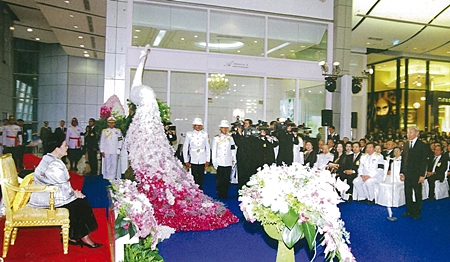 4 August, Her Majesty the Queen presiding over the Opening Ceremony of the Royal Project Fair “42” , at the Central World Shopping complex, Pathum Wan District, Bangkok.
4 August, Her Majesty the Queen presiding over the Opening Ceremony of the Royal Project Fair “42” , at the Central World Shopping complex, Pathum Wan District, Bangkok.
The English version was appropriately translated by Mom Rajawongse Thongnoi Thongyai, Deputy Principal Secretary to H.M. the King as “The Foundation for the Promotion of Supplementary Occupations and Related Techniques, Under Royal Patronage of Her Majesty the Queen.” It became known as “The SUPPORT Foundation” and Her Majesty also took on the position of Chairperson of the Executive Board of Directors.
Her Majesty the Queen has personally managed the operation of this foundation. Therefore, it was considered most appropriate to change the foundation name to The SUPPORT Foundation of Her Majesty Queen Sirikit, Phra Baromma Rajini Nath. Changes were also made to the existing Bylaws as the original group of executive directors have passed away or are unable to continue their board duties.
The SUPPORT Foundation Headquarters at Chitralada Palace
The training center, located at Chitralada Palace in Bangkok, is considered to be the heart of the foundation, as originally planned by Her Majesty who wished to create such a center right in the palace grounds. At first it was not a permanent structure, but rather an informal area where tents were erected beside the royal secretariat.
Then, it was simply known as the art and handicraft training shed.
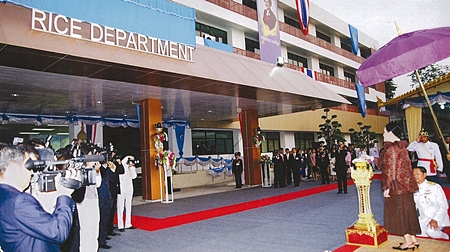 11 March, Her Majesty the Queen presiding over the Opening Ceremony of the Rice Department Headquarters, Ministry of Agriculture and Cooperative, Chatuchak District, Bangkok.
11 March, Her Majesty the Queen presiding over the Opening Ceremony of the Rice Department Headquarters, Ministry of Agriculture and Cooperative, Chatuchak District, Bangkok.
Later, there was such a rapid increase of underprivileged villagers from all over the country who were being trained at the center that a two-storey building was constructed in 1980 to house trainees, officials and handicraft products. However, space became quickly overcrowded with the increasing number of new trainees that a higher floor was added to the present building in 1982.
In August 1990, H.R.H. Princess Maha Chakri Sirindhorn contributed her own funds, which were personal gifts from the people that she had accumulated over the years, to construct a 3-storey building opposite the royal secretariat location. She personally oversaw the construction details and presented the building as a birthday anniversary gift to Her Majesty the Queen, which was officially opened by her on August 11, 1991.
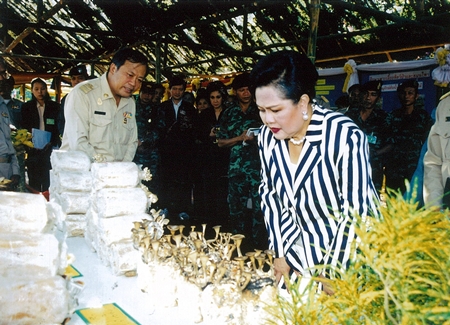
The aim of the foundation training center is not only to train these people in various skills, but also to preserve the national heritage and promote traditional arts and handicrafts. It is also the coordination center for officials and foundation members who are located in different parts of the country. It acts as the central purchasing center with suitable storage space, and the distribution center for all foundation products. Most importantly, it is also the headquarters for the SUPPORT Foundation of H.M. the Queen.
Following the establishment of The SUPPORT Foundation in 1976, there was an increasing number of projects generating supplementary income for the villagers. In the central region, a cotton weaving project was launched at Amphoe Pa Mok, Ang Thong Province on August 27, 1976; at Amphoe Bang Pahan, Ayudhaya Province on November 5, 1976; and at Amphoe Bang Ban, Ayudhaya Province on January 19, 1977. From then on, several training centers and training projects were established in all regions of the country.
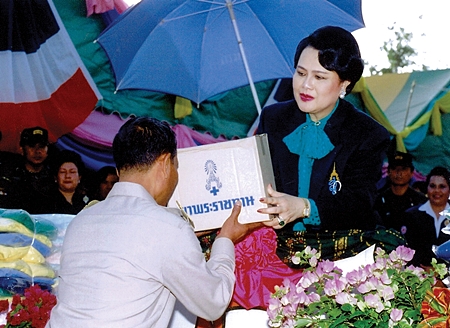
It was Her Majesty’s aim to create arts and handicrafts from local raw materials, to promote weaving and other skills in traditional designs according to the traditions of that region. This action will preserve the ancient legacy handed down through generations, and inspire and encourage the local people to create a more modern motif that can be harmoniously combined with traditional designs. Therefore, each regional product has its own well known identity that is exclusive to that particular location.
From Traditional Arts and Handicrafts to National Treasures
There is a continuous flow of creative art and handicraft items being produced at The SUPPORT Training Center at Chitralada Palace, handed down through the creativity and talent of the masters to the younger generation from provinces or handicapped persons, who are fully supported by the ever caring concern of Her Majesty the Queen.
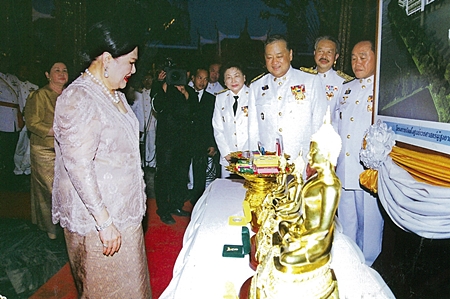 5 October, Her Majesty the Queen presiding over the Ceremony to cast Buddha Image of “Phra Bhuddaphannisridhammaphaisud” which is a Project to make the Celebrations on the Auspicious Occasion of His Majesty the King’s 7th Cycle Birthday Anniversary 5th December 2011, at the Royal Chapel in the Grand Palace.
5 October, Her Majesty the Queen presiding over the Ceremony to cast Buddha Image of “Phra Bhuddaphannisridhammaphaisud” which is a Project to make the Celebrations on the Auspicious Occasion of His Majesty the King’s 7th Cycle Birthday Anniversary 5th December 2011, at the Royal Chapel in the Grand Palace.
She is also their most supportive instructor in giving compliments and constructive advice, together with presenting prizes, showing morale support and extending necessary assistance and funds. The resulting successful production, accumulated over the years, has appeared in seven exhibitions. These masterpieces are the delight and pride of the nation.
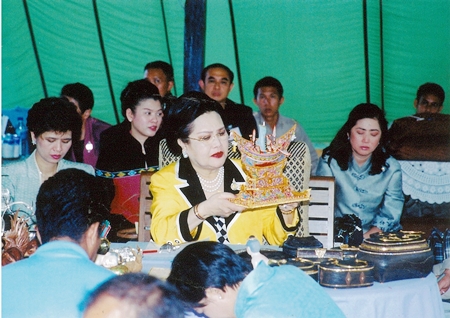
From Handicraft to Forestry and Agricultural Projects
When a member of the foundation is able to stand on his own feet, Her Majesty will start to search for new trainees and needy people to extend her support. At present, the foundation has expanded its activities to include assistance and support in the agricultural field, livestock, forest preservation for water sources, revival of local skills and expertise through numerous projects.
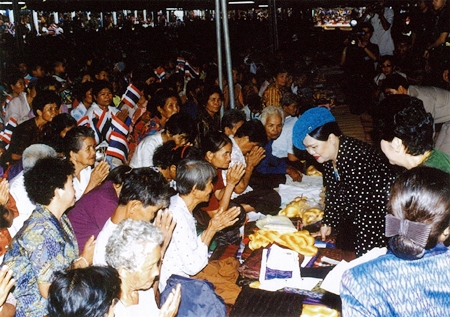
The royal entourage to Her Majesty the Queen is ever ready to lend assistance in these widespread royal projects of various nature varied schemes, from problems of nutrition, occupation, social welfare to environmental issues of the nation.
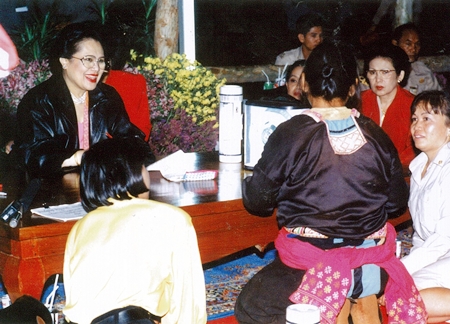
Projects Under Royal Patronage
It is now well over half a century that Their Majesties have made regular visits to their people in all corners of Thailand. From the beginning, it was apparent that, in the provinces and especially the more remote areas, their people were faced with persistent problems which contributed to many types of suffering. Some of their people lived near destitution and even in total misery. With unwavering determination, they embarked on their quest for to improve the lives of their people in the most appropriate ways. Their Majesties were well aware that many of these problems and deprivations could be reduced and even eliminated. However, without apt solutions, some of these difficulties could increase significantly to the changing social clime, environment and economy of the nation.
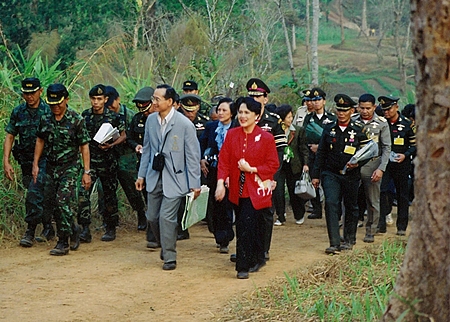
While the majority of H.M. the King’s attention was occupied with core projects to improve agriculture, H.M. the Queen was busy with the development of handicrafts and promoting the welfare of provincial women, children and the elderly. Once these projects operated smoothly, her interests diversified to environmental and some agricultural programs to assist the responsibility of numerous schemes initiated by His Majesty. She considered that agriculture could also be seen as handicraft, because farmers needed to have imagination and creativity to produce the crops and their living. Her early environmental projects were the successful Royal-initiated Forest love Water Project (Paa Rak Nam), and Royal-initiated Little House in the Big Forest Project (Ban Lek Nai Paa Yai), which were soon followed by several other thriving projects.
The Royal-initiated Forest Loves Water (Paa Rak Nam) and The Royal-initiated Little House in the Big Forest (Ban Lek Nai Paa Yai)
Her Majesty firmly believed that the most practical way of life is for man to live with the forest, and to protect while also benefiting from the available natural resources. The Royal-initiated Forest Loves Water Project (Paa Rak Nam) in Sakon Nakhon Province, villagers were educated, in simple terms, to thoroughly understand the importance and value of the forest in their lives.
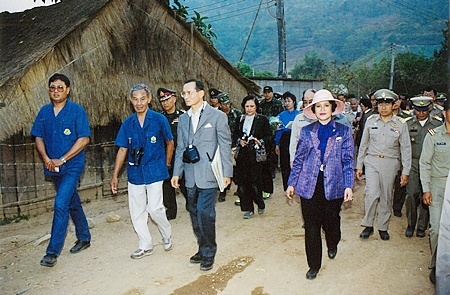
They were taught that the forests were the source of their precious water resources and so they must immediately cease to destroy the forest whether for agriculture or to take the wood. They also learned that if they were to continue to enjoy abundant natural water, they must help to preserve and expand their forested areas.
At the same time, Her Majesty commenced a project know as Doi Kham the Royal-initiated Little House in the Big Forest Project (Ban Lek Nai Paa Yai) on the hills of Chiang Mai Province.
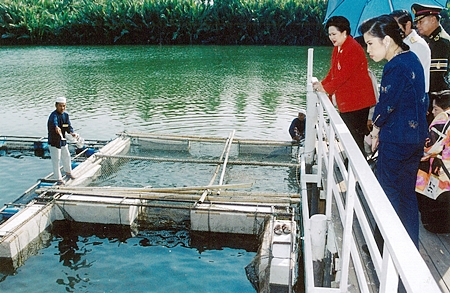
The concept was to create a community where villagers could support themselves by gathering food from the forest. As this was in a border area, they also helped with forest fire protection, safeguarding from illegal loggers, and were on the alert for illicit drug trafficking.
They were discouraged from clearing the forest for their traditional practice of shifting cultivation, which not only destroyed large areas of the forests but also left them unproductive for many years. Instead, they were taught to farm in the more permanent and productive terraced agriculture on the steep hillsides.
There are now several the Royal-initiated Little House in the Big Forest Project (Ban Lek Nai Paa Yai) throughout the Kingdom.
This project was similar to the Royal-initiated Forest Loves Water Project and other the Royal-initiated Little House in the Big Forest Project (Ban Lek Nai Paa Yai) Forest schemes. After establishing each project, Her Majesty would extend appropriate assistance and advice to help improve living conditions, no matter how remote.
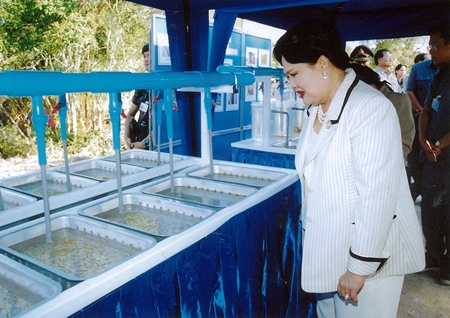
For example, the venture at Sibrae, a remote corner far from other villages towards Amphoe Omkoi in Chiang Mai Province, was only reachable by a 4-hour car trip. Another example of Her Majesty’s work was the Forest Preservation Project at Ban Huay Ja Khan, Tambol Ping Khong, Amphoe Chiang Dao in Chiang Mai, where Her Majesty had arranged for the hilltribes, who had migrated from the Muser Lang Muang, Amphoe Omkoi in Chiang Mai to re-settle. As of 2004, there were now 60 families enjoying a peaceful and productive life at this site.
The Royal-initiated Model Farm Project
“We created Model Farms in order to educate and train the villagers to increase their food stock so that they will not be faced with problems during the lean months. Secondly, it is our wish that everyone should have an occupation which will enable them to earn a living. Therefore, we extend assistance by giving them jobs at the model farm.
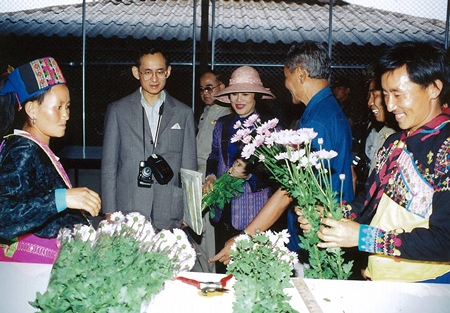
“At the same time, they begin to learn the proper way of raising chickens, ducks and other livestock.
When they are ready to start their own farms, they can put these innovative methods to good use…” – Her Majesty the Queen’s Birthday Anniversary Speech Monday, August 11, 2003 at Dusidalai Pavilion, Chitralada Palace.
The concept of the Royal-initiated Model Farm Project was not only to end forest destruction caused by shifting cultivation and opium growing production, but was also another way of extending assistance and, at the same time, educating the villagers to new agricultural methods, together with teaching them the importance of producing and storing sufficient food. The principal aim of the Royal-initiated Model Farm Project was as follows:
1.To produce quality products.
2. To educate and carry out on-the-job training in new technologies.
3. To offer employment and teach villagers new farming methods.
Later, Her Majesty commanded that the model farm should consider employment as its first priority as it was evident that the villagers and their families benefited from a regular income for food, clothes, school fees, transportation and doctors. Another advantage was that a model farm also served as a site for educational field trips for students and as a tourist attraction.
The Royal-initiated Highland Agricultural Development Station
The Royal-initiated Highland Agricultural Development Station was initiated when villagers in Mae Chaem watershed in Chiang Mai Province were suffering from a long drought. They petitioned Her Majesty for royal assistance.
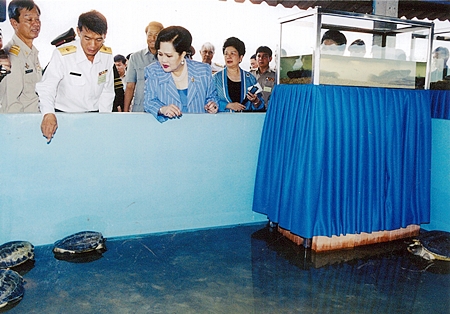
After consultation with H.M. the King, an irrigation project was initiated to alleviate these problems. Meantime, Her Majesty also set up the Royal-initiated Highland Agricultural Development Station, where experts assisted the villagers in new farming techniques which were more productive and most suitable to this particular area without having to resort to high technology or expensive machinery.
The project became a model center for neighboring villages to carry out the same successful innovative practice, which also included raising different types of crops and cultivating livestock.
The First Model Farm
“We were able to establish the first Model Farm from contributions received by The SUPPORT Foundation, which were generously donated by people throughout the country. We purchased a plot of land on a hill in Chiang Mai where there were so many destitute hilltribes. As there was such a scarcity of food, they existed by smoking opium. During our visit, they made an appeal to their “mae” or mother, for any kind of jobs for their village. In return, they were willing to destroy all the poppy fields and would start to work hard and honestly.” – Her Majesty the Queen’s Birthday Anniversary Speech, Saturday, August 11, 2001 at Dusidalai Pavilion, Chitralada Palace.
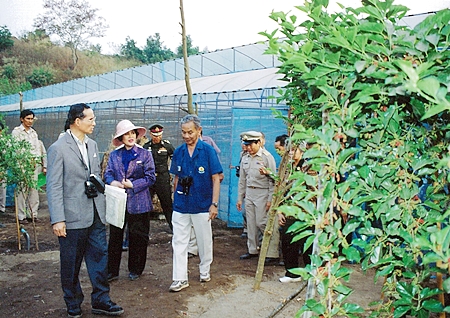
The first model farm was initiated in the northern region. When Her Majesty made a visit to Ban Khun Pae, a group of former drug addicts petitioned her for assistance as they had no way to earn a living. She commanded Sahas Boonyaviwat, Deputy Secretary-General for Special Affairs attached to the Royal Household, to search for a suitable location, which was found at Ban Khun Tae, Amphoe Jomthong, Chiang Mai Province. As it was such a remote corner, the villagers were still awaiting help for the piece of land that they had already cleared for cultivation.
Her Majesty immediately put her new plan into practice by starting a Model Farm. In fact, it was the same group of villagers who had appealed for help earlier. They were indeed fortunate that their request was so promptly realized.
Ban Mae Taam, Amphoe Soem Ngam in Lampang Province already has a flourishing handicraft center for supplementary income, but no agricultural project, so Her Majesty organized another model farm at this location, followed by another at Ban Mae Tung Ting, Amphoe Samoeng in Chiang Mai.
After these first model farms met with success, model farms were established in disadvantaged areas throughout the country.
For areas experiencing problems but unable to receive assistance from The SUPPORT Foundation, Her Majesty would contribute funds to start up a small village livestock farm, which was closely supervised by local officials. Another budget would also be allocated for maintenance, necessary construction and replenishment of livestock such as pigs, cows and ducks. For the southern region, which was more suitable for fishing and fish farming, the villagers were encouraged to cultivate Krasang fish or Garoupa at Ban Laweng.
The Forest Preservation to Protect Life Flag
In November 1995, Her Majesty was in residence at Phuphan Rajanives Palace in Sakon Nakhon Province. The then Colonel Pichet Visaijorn informed her that 12 families living in the area of Paa Dong Yai forest were suffering because the land they had previously farmed had become very infertile and unproductive. Through joint cooperation, they decided to stop farming and instead start restoring the forest until the area would be once more lush and green.
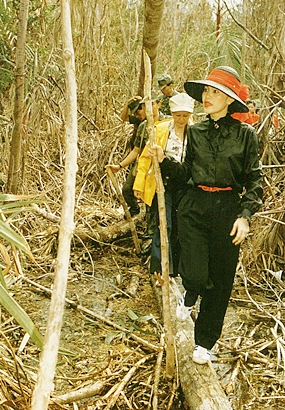
Her Majesty felt that such a good deed should be rewarded and honored to become an incentive for other villagers to follow this fine example.
Therefore, a royal Forest Preservation to Protect Life Flag was created and presented to the villagers of Paa Dong Yai, Amphoe Hua Taphan in Amnat Charoen Province, which was soon followed by the villagers of Dong Na Tham in Ubon Ratchathani Province who also worked as a community to protect their forests.
The Forest Preservation to Protect Life flag of honor is blue, 80 cm. wide and 114 cm. long, decorated with a crown in the center and H.M. the Queen’s royal initials SK in an oval space. The center is also decorated with two trees flanked by 1, 2 or 3 elephants in accordance with the grade of the flag. The edge is embroidered with dark blue silk.
Blue is Her Majesty’s personal color, green indicates a cool and pleasant area, trees for the forest and elephants mean a prosperous land.
The Forest Preservation to Protect Life flag is used for activities concerning the preservation of forest, wildlife and the environment and is proudly flown by the villagers. However, if it is discovered that the villagers have not kept up their vigilance, then the flag will be removed.
Forest Preservation Volunteers-Ror Sor Por Tor
The Forest Preservation Volunteers are villagers who actually live in the area where the forest is being protected. Although capable and alert in their protection tasks, their efforts have not reached the required standard to achieve a Forest to Preserve Life Flag. Therefore, in order to show appreciation for their vigilance, Her Majesty has set up a Forest Preservation Volunteers Unit, known by the initials Ror Sor Por Tor, with regular training by forestry officials and military personnel to promote the proper way of life to achieve “harmony between man and forest.”
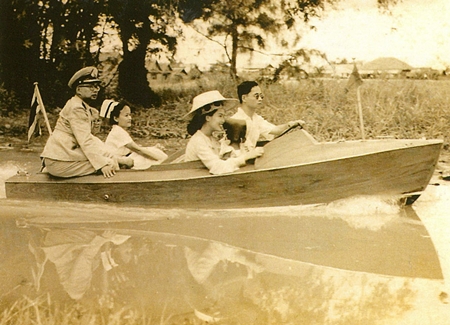
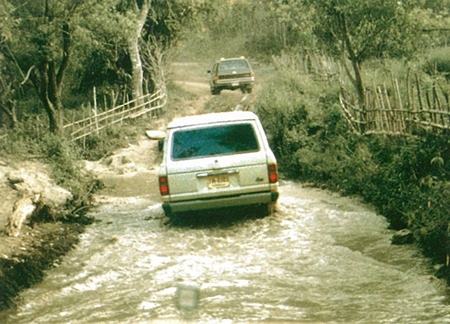
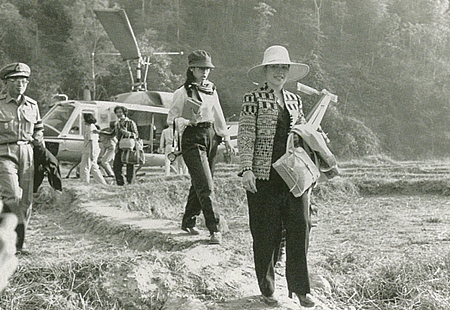
The Royal-initiated Coastal Resources Rehabilitation Project
It was Her Majesty’s custom to make regular visits to Ban Laweng in Pattani, where she would hold work sessions at the pavilion with local villagers, and those from nearby Ban Rang Mod Dang, Amphoe Mai Kaen.
At one time, villagers petitioned for royal assistance as fishing was becoming very scarce. Her Majesty discussed this issue with the fisheries officials and mentioned that the villagers were hoping to have some sort of refuge for the fish to lay eggs in, which could also act as a safe shelter away from fishing nets. At that particular time, the railway department was about to offer old rail carriages for sale. This was an ideal solution and the train carriages were transformed into fish houses, and would also act as a stimulus to develop new coral reefs.
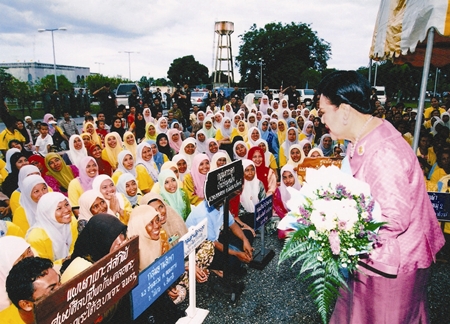
H.M. the King advised the officials concerned to carefully study the terrain as the act of sinking large train carriages into the sea could cause water flow problems and might even be ecologically harmful. After careful consideration, during the first year, a fleet of 200-300 train carriages were sunk around Sai Buri, which was about 10-12 kms from shore at a depth of 25 to 25 meters. The next drop was only 3 kms from shore. Within one year, schools of huge fish such as Potato Cods or Pla Moh Talay, whose size were larger than the train windows, could be seen happily swimming around the new “homes”, which were already heavily covered with oyster shells and coral.
Food Bank
It was Her Majesty’s farsighted vision, and her firm belief, that if people were fed and led a reasonably happy life, they would not seek to destroy forests in order to make a living, and would not even consider other dishonest means to earn money. Therefore, she established the Food Bank with the purpose of ensuring that villagers would have sufficient food stored to last during the lean months.
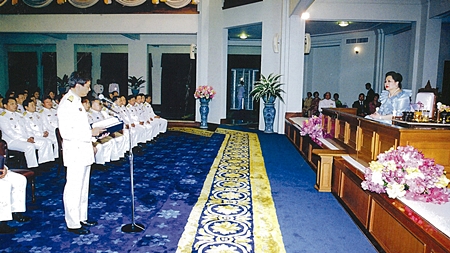 26 July, Her Majesty the Queen granting an audience to members of the “Mother of the Nation Fund” Committee who came to receive contribution from the fund to be used in preventing and solving the narcotics problem, at Dusidalai Hall in the grounds of Chitralada Villa, Dusit Palace.
26 July, Her Majesty the Queen granting an audience to members of the “Mother of the Nation Fund” Committee who came to receive contribution from the fund to be used in preventing and solving the narcotics problem, at Dusidalai Hall in the grounds of Chitralada Villa, Dusit Palace.
At first, the idea was put into practice to support farmers who were unable to produce anything because of a long drought or a flood disaster. Food and grains were distributed to help the villagers survive during such hard times.
When the fields were productive again, villagers reimbursed the food banks with some of their produce. For food banks located outside agricultural areas, villagers were able to make their reimbursements with some other available produce.
The Food Bank concept came out of true royal support or royal sponsorship. A granary would be constructed as a food bank to stock rice and grains, which was supervised by the village committee, selected by the villagers themselves. Regular reports would be made to local officials and sometimes regional military units. At present, there are over 200 Food Banks located all over Thailand.
The Promotion of Caladium Culture Project
The colored caladium plants are quite rare and much sought after by avid gardeners. However, they are rather difficult to cultivate due to their delicate nature. The green leaves are beautifully streaked with a reddish-pink glow or they can turn bronze-red all over, an appearance much admired by experts.
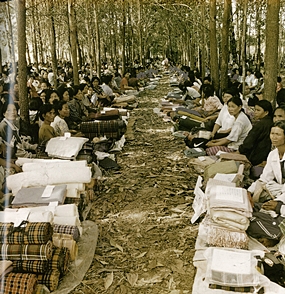
Her Majesty was concerned that this beautiful plant could soon become extinct, and initiated a project to research the best cultivation, and at the same time to further improve its beauty. When Her Majesty was in residence at Taksin Rajanives Palace, where she regularly held handicraft competitions on Yan Lipao, Krajude, Rua Gorae and other items, she suddenly realized that the southern climate was most suitable to raise these colored caladium plants. If encouraged and nurtured properly, it could become another successful project to provide supplementary income for the southern people. The project was established in 1998 and annual competitions, entered by villages from the three southern-most provinces, were held for the flourishing colored caladium plants.
The many projects, established by Her Majesty’s the Queen, all progress in line with the concept of development and advancement for a better living.
First, the existing problems are solved, especially with regard to lack of food. Then after careful consideration, a suitable solution is found together with an appropriate occupation initiated for these many different areas.
With her far-sighted vision and supreme benevolence, Her Majesty continues with her lifelong mission in improving the quality of life and welfare of her people.
International Acclaim
“As for this prestigious award, I myself as another Thai citizen, received it with pride on behalf of all our people. It will be an honor to take this award back to our country. It clearly shows that the Thais are now well known and admired by overseas people.” – Her Majesty the Queen’s Speech on the occasion of an informal audience with the Thai Community during her Official Visit to receive an award at the Grand Ballroom, Plaza Hotel, New York City, U.S.A. November 5, 2001.
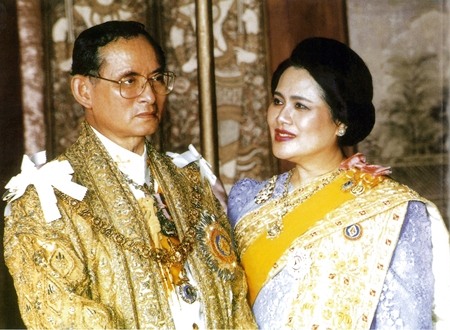
From the glorious celebration of her Royal Wedding day over half a century ago, Her Majesty the Queen has dedicated her time, strength and energy following in the direction, clearly set by H.M. the King, with regard to the advancement of the nation and the development of welfare for their people. With her indomitable spirit and determination to alleviate the hardships experienced by those in underprivileged and remote areas, she was also resolute in her wish to bring the country and its potential to the attention of the global arena, as Thailand was a relatively unknown entity fifty years ago.
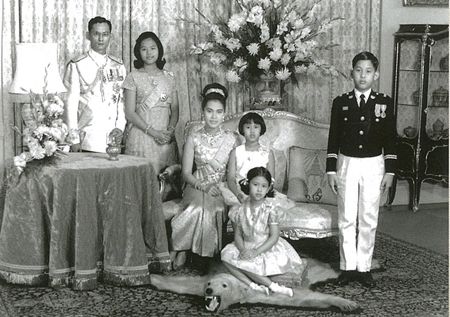
Through decades of dedication and hard work, Her Majesty has been instrumental in bringing the country into the global limelight and gaining worldwide recognition. Among other attributes, Thailand is now famed for its charming traditions and creative talents. It is no wonder that, through the years, both international and local organizations, and institutions, have honored her with exceptional awards and university degrees.
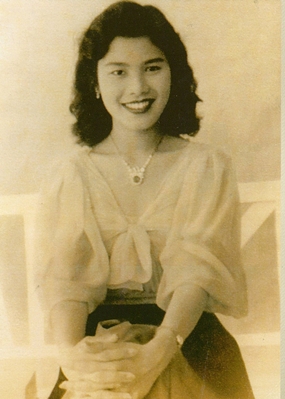
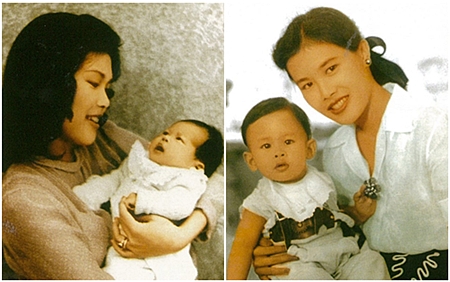
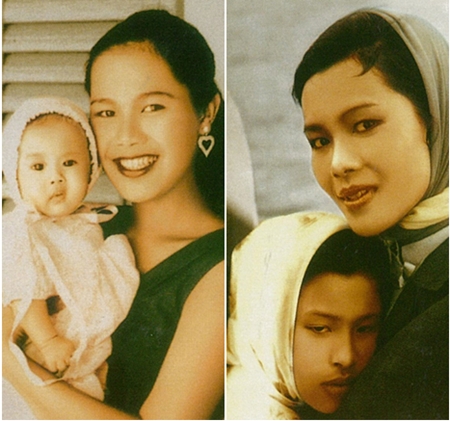
Handicraft Promotion
When Their Majesties finally returned to Thailand after these long and strenuous trips, H.M. the Queen continued with her various handicraft projects and numerous other occupations such as promoting educational and social welfare schemes, supporting women’s rights issues, establishing plans for environmental preservation and restoration of forest and wildlife, commencing campaigns for charitable organizations and acting as head of the Red Cross Society. With ever increasing responsibilities over these numerous projects, it was not possible for Her Majesty to make many visits overseas.
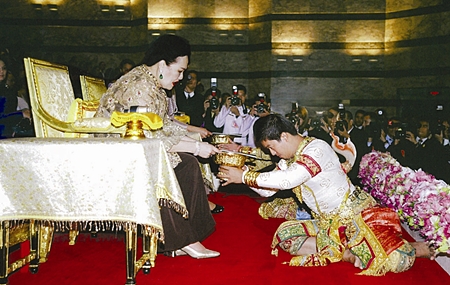 14 July, Her Majesty the Queen, accompanied by Her Royal Highness Princess Maha Chakri Sirindron, during the “Khon” performance of “Suek Miyarap” Episode at Thailand Cultural Center, Huai Khwang District, Bangkok.
14 July, Her Majesty the Queen, accompanied by Her Royal Highness Princess Maha Chakri Sirindron, during the “Khon” performance of “Suek Miyarap” Episode at Thailand Cultural Center, Huai Khwang District, Bangkok.
However, when the SUPPORT Foundation was firmly established and its members at the training center at Chitralada Palace in Bangkok were producing exceptional traditional handicraft items, some of which were truly exquisite masterpieces, it was time to promote these treasures overseas. With great pride, Her Majesty wished to let the world see how simple farmers could create the most beautiful and delicate works of art. When her intentions were known, invitations were extended from the United States, Japan and France for Her Majesty to organize exclusive exhibitions. At major cities such as Washington, D.C. and Los Angeles, the American people were able to enjoy these wonderful exhibits, with a special introduction and narration by Her Majesty.
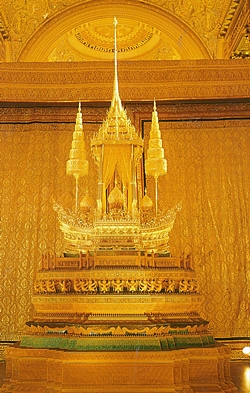
In Japan, Her Majesty escorted Emperor Akihito and personally introduced these treasures at a grand exhibition. He was most impressed and interested in these magnificent handicrafts. The Japanese viewers, well known for their selective and discerning taste, wished to immediately purchase several pieces, but unfortunately, these exhibits were on show only. However, Japanese designers were so impressed with the Mudmee Thai silk that they used this lovely fabric to create elegant kimonos, which were included in a special fashion show.
In France, a unique exhibition was held at the Eiffel Tower which was accompanied by leading artists from The SUPPORT Foundation. Madame Chirac, wife of the President of France, was delighted with these remarkable items and commented on the surprising creative talent of simple Thai farmers.
Rich with an ancient culture, charming traditions and inspirational handicrafts, it has always been Her Majesty’s steadfast objective to present the opulent heritage of Thailand to the world. Now, her wish has been fully realized. As Asther Coopersmith of the Children’s Museum in Washington, D.C., who has had the opportunity to be in attendance to Her Majesty on several occasions, comments:
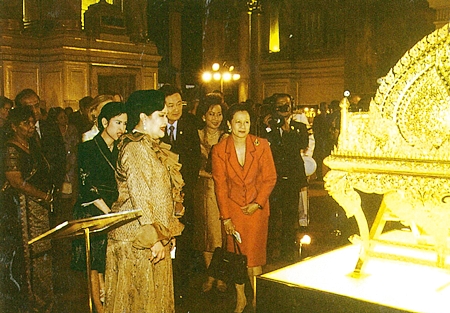
“For Her Majesty, the culture, tradition, and the ever increasing potentials of Thailand are her first priorities. She has an infinite pride and loving concern for her people and takes every opportunity to show the impressive culture and traditions, together with the rich treasures of Thailand. These are definitely the most sophisticated mode and effective approach to promote friendship and understanding between Thailand and the rest of the world.”
International Acclaim
Through the decades, Her Majesty continued with her hard work and single-minded devotion in responding to the directives and required actions, as set by H.M. the King, in the total commitment to their country. It was their royal duty and responsibility to extend assistance to their deprived subjects. They were both earnest in their various undertakings in order to enhance and improve the welfare of their people.
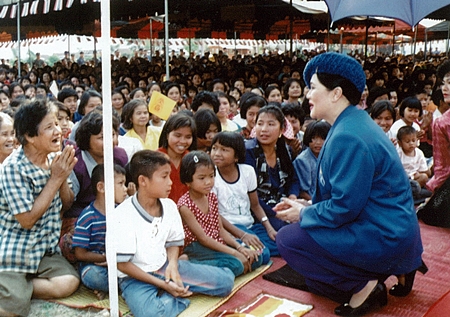
International organizations have shown their recognition and warm appreciation for her long and arduous endeavors by presenting Her Majesty with high honors and exceptional awards for her various accomplishments.
State Visits
In 1960, Their Majesties embarked on a lengthy journey to make a series of state visits overseas. The impact of such an undertaking was truly memorable. Thailand, with its young monarch and exquisite queen, was suddenly identified as a most attractive prospect for trade and travel. The royal couple was most warmly welcomed by royalties and heads of state throughout the western world. Over the years, these illustrious leaders made reciprocal visits to Thailand, which have resulted in much closer relationships between the countries. In fact, Their Majesties have effectively opened the doors to Thailand. Later, they also made state visits to neighboring countries, both in Asia and the Pacific.
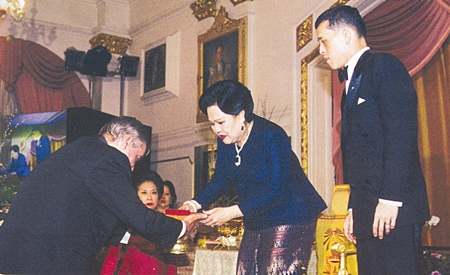
Her Majesty’s most recent Royal activities
Her Majesty the Queen has been a constant companion by H.M. the King’s side throughout the year. Whenever H.M. the King has been able to visit his loyal subjects, H.M. the Queen always accompanied him. Some of these visits included:
On 29 February 2012, Their Majesties the King and Queen gave an audience to His Royal Highness the Duke of York of the United Kingdom, in the HRH Princess Galyani Vadhana conference hall, Chalermprakiet building, during the Duke’s visit to Thailand to present a congratulatory message from HM the Queen Elizabeth to HM the King on the auspicious occasion of His Majesty 84th Birthday / 7th Anniversary on 5th December, 2011.
On 20 April 2012, Their Majesties the King and Queen left Siriraj Hospital to visit Wat Srirattanasasdaram where they were welcomed by HRH Princess Sirindhorn to admire paintings of Ramakien that have been painted on the balcony surrounding the temple.
On 27 April 2012, Their Majesties the King and Queen visited Somdej Phrapan Vassa Ayikajao museum and exhibition in Wat Prathum, welcomed again by HRH Princess Sirindhorn and the committee from Somdej Phrapan Vassa Ayikajao Foundation.
On 28 April 2012 Their Majesties the King and Queen left Siriraj Hospital with Crown Prince Maha Vajiralongkorn, HRH Princess Sirindhorn, HRH Princess Chulabhorn and Princess Sirivannavari Nariratana and made merit on the anniversary of the royal marriage.
On 5 May 2012, Their Majesties the King and Queen with Crown Prince Maha Vajiralongkorn participated in Coronation Day ceremonies offering alms to monks and Brahmans followed by a candle lit ceremony, where a lit candle was used to light another candle, and so on, at Amarindra Vinichaya Throne Hall, the Royal Palace.
On 25 June 2012, Their Majesties the King and Queen, with HRH Princess Sirindhorn welcomed Prince Naruhito, Crown Prince from Japan, on his royal visit to Thailand and was honored with private royal dinner by HM the King and Queen in the Royal Palace.
On 7 July 2012, HM the King left his chambers in the 16th floor of Chalermprakiet building, in his royal wheelchair with HM the Queen and HRH Princess Sirindhorn and travelled on the Angsana ship to Siriraj pier to officially open 5 irrigation projects.
